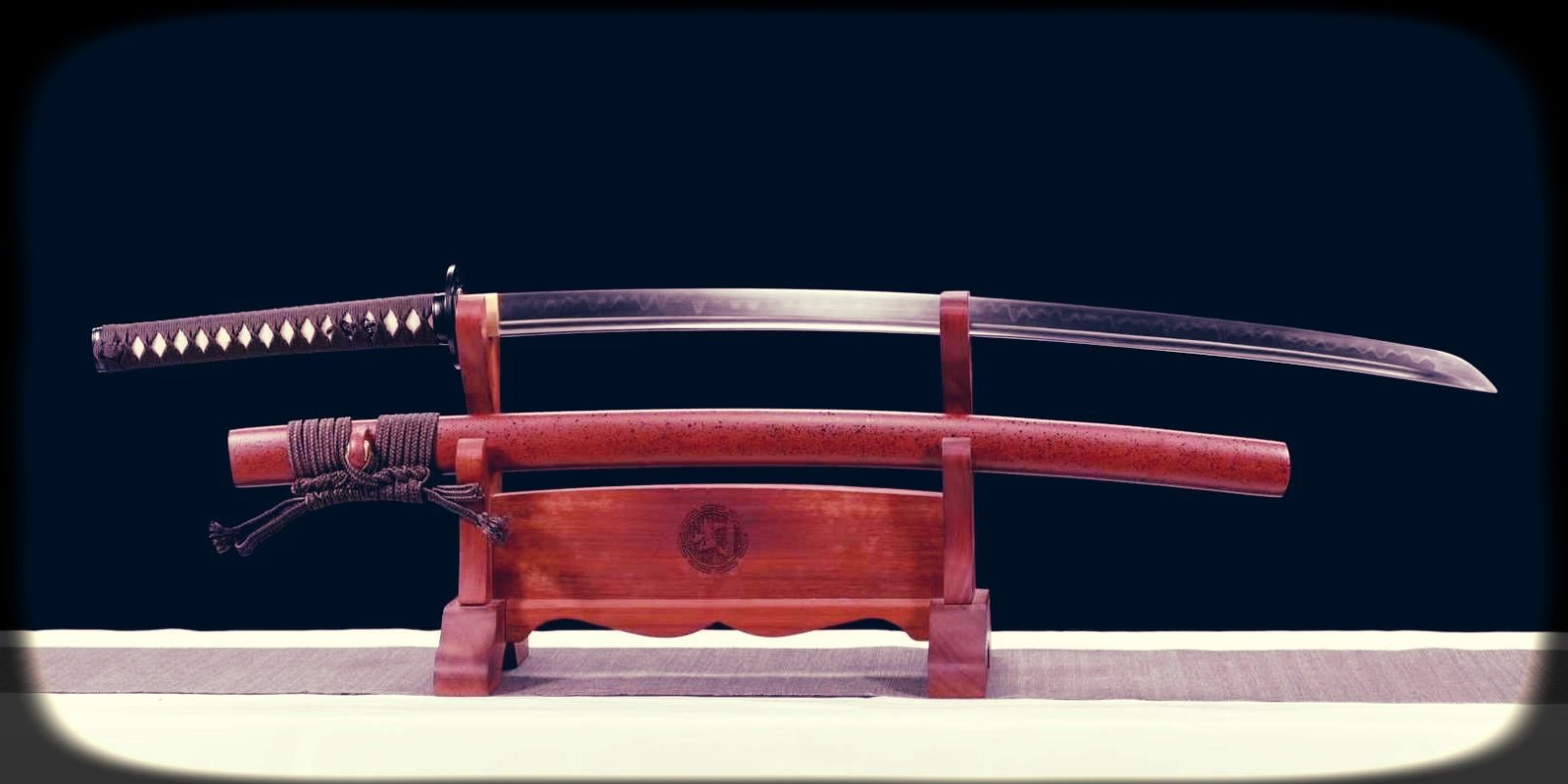Understanding the Art of Katana Craftsmanship
The art of katana craftsmanship represents a centuries-old legacy of precision, tradition, and innovation. Each element of a katana is meticulously forged, reflecting both cultural significance and the technical brilliance of Japanese blacksmiths. From the maru steels used in forging katanas to advanced techniques like sanmai gitae, the process embodies unparalleled mastery.
A katana’s components are not merely functional but also hold aesthetic and symbolic value. The blade (nagasa) serves as the centerpiece, with features such as a misty yakiba, a mirror-polished shinogi-ji, and decorative wave-like patterns known as hamon. Traditional bizen nagamitsu blades highlight how forging techniques promote both strength and elegance. Complementing the blade are the tsuka (handle), tsuba (hand guard), and scabbard (saya), which integrate art and utility. The popular ebony saya seen in models like the "Katana Cloud Dragon Damascus" demonstrates how craftsmanship balances form and functionality.
Ensuring the authenticity and value of Japanese swords, such as an antique nihonto katana signed by Naokuni, often includes tangible proof like the NBTHK Tokubetsu Hozon certificate. Authentic nihonto swords draw collectors worldwide due to their historical significance and fine detailing. The mastery imbued in these blades conveys centuries-old techniques that endure today.
Proper maintenance, such as protecting swords from rust and maintaining katana blades with specific oils and tools, is essential. Expertly preserved blades retain their sharp edge, misty yakiba, and large-wave hamon. Collectors and users alike must prioritize techniques to safeguard these works of art.
This craftsmanship is not a mere skill but a testament to dedication and tradition, showcasing the forging of steel into legendary swords. Every hand-shaped blade, every curve of the hamon, tells a story of enduring legacy.
Materials Required for Forging a Legendary Katana
Forging a legendary katana demands not only superior craftsmanship but also the finest materials, chosen meticulously to achieve the characteristics that define the blade's beauty and functionality. Each component contributes to the unique properties of the weapon, from its misty yakiba to the large wave hamon and mirror-polished shinogi-ji.
Core Steels and Their Applications
- Tamahagane (Jewel Steel): This premium Japanese steel, produced in a traditional tatara furnace, forms the heart and soul of a katana blade. Its high carbon content allows for the sharpness and distinctive edge needed for precise cutting.
- Maru Steel: Often utilized in simpler katana designs, maru steel provides a uniform composition suited to blades that do not employ the intricate sanmai-gitae or soshu kitae forging techniques.
- Damascus Folded Steel: A favored material for modern collectors, this steel, as seen in the "Katana Cloud Dragon Damascus," exhibits mesmerizing wave-like patterns achieved through multiple foldings, ensuring strength and visual allure.
Supporting Components of the Blade
- Clay Mixture: Used during the clay tempering process, clay, mixed with charcoal and ash, controls the cooling rate of the blade during quenching. This creates the famed hamon and ensures harder edges while maintaining a softer, more resilient spine.
- Ebony Saya: Chosen for its durability and visual sophistication, ebony saya ensures the katana blade is housed safely, protecting it from environmental factors like humidity and rust.
- Koshirae (Fittings): Securely mounting the blade, components like the tsuba (guard), tsuka (handle), and habaki (collar) add balance and aesthetic value.
Preserving Authenticity and Value
Collectors of authentic nihonto, like an "Antique Nihonto Katana Signed by Naokuni" possessing a prestigious NBTHK Tokubetsu Hozon Token certificate, must ensure the integrity of these materials. High-grade oils, frequent maintenance, and storage in controlled conditions protect the sword from deterioration, ensuring a legacy of excellence, akin to the mastery exemplified by the blades of Bizen Nagamitsu.
Each material in a katana’s construction is carefully chosen to uphold centuries of tradition, guaranteeing a balance of artistry, function, and cultural prestige.
The Importance of Steel Folding in Katana Crafting
Steel folding is a cornerstone technique in the intricate process of crafting a katana, blending tradition, precision, and metallurgy. Central to this art form is the use of maru steels, which serve as a foundational material in forging katanas, providing the combination of durability and flexibility required for a functional and resilient blade. By folding steel multiple times during the forging process, impurities within the raw material are systematically eliminated, resulting in a homogenous mix. This meticulous folding technique also contributes to the subtle aesthetic details, such as the "cloud dragon" patterns seen on specialized blades like the katana cloud dragon damascus folded clay tempered ebony saya.
The process of layering and folding steel creates many benefits. It strengthens the blade while enhancing its flexibility—a critical factor in protecting swords from shattering upon impact. This elaborate folding also ensures a rich texture in the blade's surface, which, when paired with techniques like mirror-polished shinogi-ji or the misty yakiba finish, yields a katana with both functional excellence and visual artistry. For instance, authentic nihonto katanas often feature a large wave hamon, demonstrating meticulous steel manipulation and clay-tempering techniques.
Folding also plays a significant role in the blade's authentication. As seen in antique nihonto katanas signed by master smiths like Naokuni, verified with NBTHK Tokubetsu Hozon Token certificates, the visible grain patterns (jihada) can be crucial for confirming a sword's heritage and value. This tradition of folding, further enriched by the mastery of smiths like Bizen Nagamitsu, continues to uphold the legacy of Japanese sword craftsmanship. Proper maintenance of these blades, such as oiling and handling to prevent rust, ensures their longevity and enduring brilliance.
Creating the Perfect Blade Shape and Structure
Crafting a katana involves a meticulous forging process aimed at achieving the perfect balance of strength, sharpness, and flexibility. Central to this process is the choice of steel, with artisans often selecting maru steel for its durability and adaptability. The forging starts with the layering and folding of steel, such as the cloud dragon Damascus folded technique, which enhances the blade’s strength while creating intricate grain patterns known as hada. These methods embody a legacy forged in steel, akin to the mastery of Bizen Nagamitsu, whose techniques continue to inspire modern smiths.
To create traditional katana blades, smiths frequently employ specialized methods such as sanmai gitae forging. This process involves sandwiching a hard steel core with softer steel layers, resulting in a katana blade that combines resilience and sharpness. Key components of a katana, including the misty yakiba and mirror-polished shinogi-ji, are meticulously crafted to offer aesthetic beauty and functional performance. The distinctive large wave hamon, created through differential clay tempering, is a hallmark of authenticity and craftsmanship.
Ensuring the authenticity and value of Japanese swords involves meticulous attention to these details, often supported by certificates like the NBTHK Tokubetsu Hozon Token. For instance, an antique nihonto katana signed by Naokuni bears historical and cultural significance, verified by such certification. However, maintaining these masterpieces requires care. Regular cleaning, oiling, and proper storage help protect the blade from rust, preserving its integrity.
From authentic nihonto to a katana with an ebony saya, the careful crafting of structure ensures the swords' legendary endurance and beauty. The katana remains an enduring symbol, celebrating both ancient and modern steel craftsmanship.
Mastering the Art of Tempering and Sharpening
The tempering and sharpening phase is a pivotal step in the craftsmanship of a katana, marking the transition from raw steel to a functional blade steeped in both beauty and deadly precision. This elaborate process brings to life the katana's unique traits, such as the misty yakiba, the large wave hamon, and the mirror-polished shinogi-ji, all of which are hallmarks of authentic nihonto forging.
Tempering is introduced to stabilize the blade after forging, ensuring balance between hardness and flexibility. As seen in masterpieces like the katana blades crafted by Bizen Nagamitsu, tempering is delicately calibrated, often involving controlled heating and cooling cycles. This level of mastery prevents brittleness while enabling the edge to maintain its sharpness over time. In a katana with maru steel or intricate techniques like sanmai-gitae, precise tempering enhances the integration of different steel layers, producing a blade with both functional and aesthetic brilliance.
During sharpening, artisans meticulously hone the edge using progressively finer whetstones. This multi-stage process refines the katana's cutting capability while accentuating its decorative elements such as the cloud dragon Damascus patterns or the hamon. A painstaking, hand-polished finish is vital for revealing the sword's true character, whether it's to maintain an antique nihonto or modern interpretations like the clay-tempered ebony saya designs. The sharpness achieved is not only pivotal for performance but also essential for preserving the blade’s intrinsic value.
Proper maintenance must follow, as even the sharpest blades are susceptible to rust. Sword custodians often emphasize frequent oiling, especially for antique nihonto such as a katana signed by Naokuni, complete with NBTHK Tokubetsu Hozon certificates. By mastering tempering, sharpening, and preservation, the authenticity and value of Japanese swords are safeguarded for generations to come.
Adding the Final Touches: Handle and Aesthetic Details
The culmination of crafting a katana involves not only functional precision but also the intricate aesthetic and structural details that define its value and authenticity. The tsuka (handle) is an essential component of a katana, designed for optimal grip and balance. It is carefully shaped and wrapped with ito, a silk or leather cord, over the rayskin (samegawa). This process requires precision to ensure the handle remains secure during use, encapsulating the classical elegance associated with authentic nihonto.
The saya (scabbard) offers both protection and an artistic outlet. For instance, a katana with a cloud dragon Damascus folded clay-tempered blade often features an ebony saya, highlighting the interplay of tradition and modern craftsmanship. A perfect fit ensures the blade is sheathed securely, protecting the intricate hamon, such as large wave patterns, and the polished shinogi-ji.
A katana blade developed through sanmai gitae forging, finely producing misty yakiba, must be finished with a mirror-like polish. This step is critical as it enhances the blade's aesthetic appeal and reveals the hamon's true elegance. Such highly refined techniques reflect the mastery seen in historical examples like the antique nihonto katana signed by Naokuni, often bearing an NBTHK Tokubetsu Hozon Token certificate to authenticate its lineage and value.
Attention is also paid to fittings, such as the tsuba (guard), fuchi-kashira (collar and pommel), and menuki (grip ornaments). These often bear elaborate engravings or themes that align with Japanese culture and personal taste. Maintaining these components is imperative; to protect swords from rust, regular oiling and cleaning are crucial.
Collectors often seek katanas that reflect mastery parallel to legends like Bizen Nagamitsu, ensuring their investment's authenticity and historical significance. The details added at this stage transform the sword from a weapon into a treasured artifact, carrying a legacy forged in steel and tradition.

